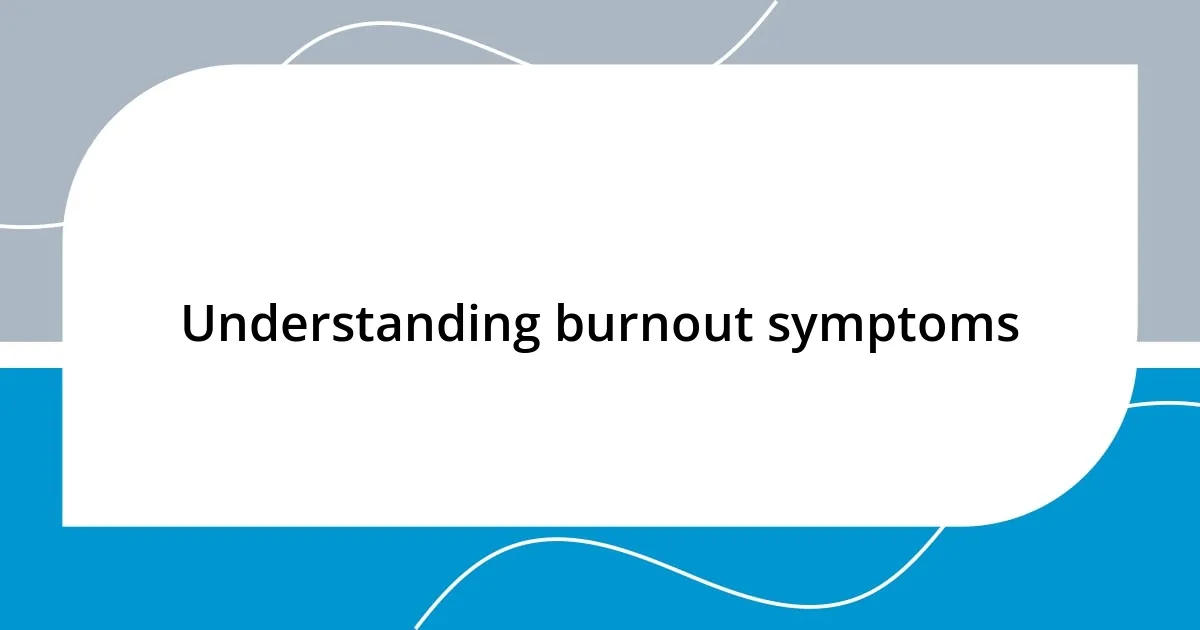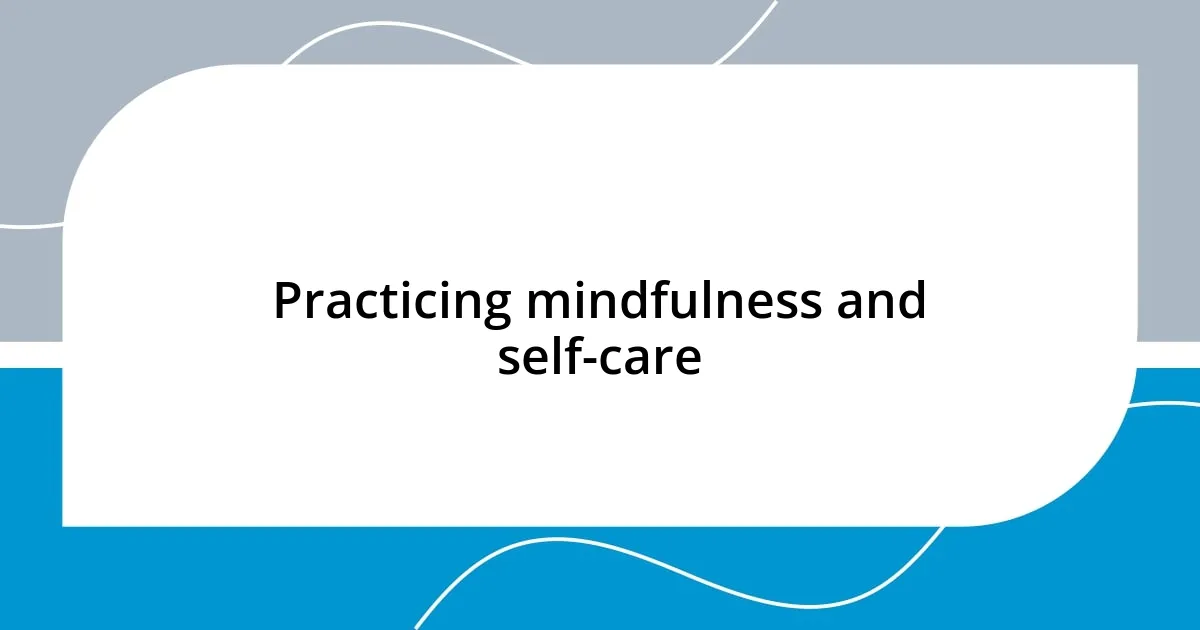Key takeaways:
- Burnout symptoms include physical fatigue, emotional detachment, and irritability; recognizing these signs early is crucial for intervention.
- Identifying personal triggers such as overcommitting, negative environments, and unclear boundaries helps in managing stress effectively.
- Implementing effective time management techniques like prioritization, time blocking, and the Pomodoro Technique enhances productivity and reduces overwhelm.
- Practicing mindfulness and maintaining a work-life balance through dedicated personal time and support systems are essential for preventing burnout.

Understanding burnout symptoms
Burnout symptoms can manifest in various ways, often creeping up on you before you even realize what’s happening. I remember feeling constantly drained and irritable; tasks that once excited me began to feel like heavy lifts. Have you ever noticed how your patience thins over seemingly trivial issues? That’s a telltale sign.
Physically, burnout can take a toll on your body too. I used to brush off my persistent headaches and fatigue, thinking they were just part of a busy life. But, looking back, those were clear warnings from my body, signaling that something was off. It raises the question: how often do we ignore our body’s signals until they become unignorable?
Emotional detachment is another common symptom that can sneak up on you. I found myself zoning out during conversations, struggling to connect with friends and family. It felt like I was watching my life from the sidelines. Can you relate? Recognizing these emotional shifts helps in addressing burnout before it spirals further.

Identifying your personal triggers
Identifying your personal triggers is essential in the battle against burnout. For me, it’s been an eye-opener to realize what specific situations make me feel overwhelmed. I remember a time when meetings blended into my daily routine, draining my energy and focus. Now, when I notice a quickening heartbeat or a sense of dread before meetings, I know I’ve hit my limit, and it’s time to reassess my schedule.
To kickstart your awareness, consider these common triggers:
– Overcommitting: Taking on too many responsibilities can lead to feeling stretched thin.
– Negative environments: Surrounding yourself with unsupportive people can amplify stress.
– Monotony: Engaging in repetitive tasks without variance can diminish excitement and increase fatigue.
– Unclear boundaries: Allowing work to intrude into personal time erodes the divide we need for a healthy mindset.
By recognizing these triggers, I’ve learned to manage my responses effectively, which has become a game-changer in my efforts to maintain balance.

Implementing effective time management
Implementing effective time management is fundamental to preventing burnout. I vividly recall the days when my calendar was jam-packed, leaving no room for breaks. There was one project that I took on, thinking multitasking would help, but instead, it left me feeling like a juggler with too many balls in the air. Have you ever felt that pressure? I’ve learned that prioritizing tasks and allowing time for completion dramatically reduces stress and enhances productivity.
Creating structured blocks of time for specific projects has been transformative for me. I often use techniques like the Pomodoro Technique, where I work intensely for 25 minutes and then take a short break. Initially, I was skeptical, wondering if short bursts would actually yield results. But I’ve found that I feel more refreshed and focused after breaks, resulting in higher-quality work and less mental fatigue. What strategies have you tried that worked wonders?
I also believe in the power of saying no. I used to feel obligated to accept every request, whether work-related or social, which only led to overwhelm. By setting clear boundaries and choosing what truly deserves my time, I’ve reclaimed my energy. It feels empowering to take control over my schedule rather than letting events schedule me! What about you? Have you found the courage to draw your boundaries?
| Time Management Method | Description |
|---|---|
| Prioritization | Identifying and focusing on critical tasks that need immediate attention, which helps reduce overwhelm. |
| Time Blocking | Allocating specific time slots for different tasks to create a structured routine and ensure focused work. |
| Pomodoro Technique | Working in short bursts followed by breaks; helps maintain energy levels and prevent fatigue. |
| Setting Boundaries | Learning to say no to non-essential tasks to protect your time and energy from being depleted. |

Establishing work-life balance
Establishing work-life balance has been a journey for me, filled with twists and turns. Early in my career, I mistook constant availability for dedication, often responding to emails late into the evening and sacrificing quality time with friends and family. It took a few eye-opening conversations with friends to make me realize how important those moments are. Have you ever felt the weight of a missed dinner with loved ones linger in your mind? I now block off evenings for personal time, a simple habit that has cultivated joy in my life once again.
When I look around my workspace, I’m reminded of how crucial a physical boundary is for separating work from relaxation. There was a time when my laptop was a constant presence at home, making it all too easy to slip into a work mindset. I decided to create a dedicated workspace that I could leave behind at the end of the day. This small change has made a huge difference. I no longer feel like I’m perpetually “on call,” which allows me to fully engage in my leisure activities, whether it’s reading, exercising, or just being with my family. Can you relate to needing that distinct separation?
Mindfully scheduling “me-time” has become essential for me as well. I used to fill every spare moment with productivity, thinking I was being efficient, but it left me feeling depleted. Incorporating activities like yoga or simply taking a walk became non-negotiables on my calendar. Initially, I wondered if prioritizing self-care felt selfish— but I quickly realized it’s essential. I have a more positive outlook and a clearer mindset when I take care of myself. What about you—do you carve out time just for your own well-being? Trust me, it’s not just important; it’s transformative.

Practicing mindfulness and self-care
Practicing mindfulness has become a vital part of my everyday routine. I remember a particularly stressful week when I felt like I was on autopilot, just rushing from one task to another. It was during that time that I stumbled upon meditation. At first, I was skeptical. How could sitting still for a few minutes change anything? But once I committed to it, I discovered a profound sense of calm that left me recharged, allowing me to tackle my challenges with a clearer mind. Have you ever experienced the power of just pausing and breathing?
Self-care, too, is often underestimated. There was a time when I brushed off my physical health, thinking exercise was an optional luxury. But after realizing how good it feels to move my body, I incorporated regular workouts into my routine. Now, those moments spent sweating it out at the gym or going for a run are my sanctuary. It’s where I clear my head and let go of the day’s pressures. Could it be that the solution to feeling overwhelmed lies in giving ourselves permission to unwind and recharge?
I’ve also learned the value of small, mindful practices throughout the day. For example, I make it a habit to take short breaks just to step outside and feel the sun on my face. It might seem trivial, but that brief connection with nature has a magical way of revitalizing my spirit. In those moments, I often think, how many of us forget to enjoy the simple things? By integrating these acts of self-care, I not only stave off burnout but also cultivate a greater appreciation for life. What simple joys do you cherish that could become a regular part of your routine?

Utilizing support systems
Utilizing support systems has been a game changer for me. When I first started experiencing the signs of burnout, I hesitated to reach out for help. However, one day, feeling particularly overwhelmed, I decided to confide in a colleague who seemed to share similar struggles. The relief I felt when she responded with empathy and shared experiences was almost instant. Have you ever had that moment of realization that you’re not alone? It made me recognize the value of surrounding myself with supportive individuals who understand the weight of workplace stress.
I’ve learned that leaning on friends and family can also provide a crucial outlet. Just last month, I found myself stuck in a loop of anxiety before a big project deadline. Instead of keeping it to myself, I called a close friend to share my feelings. It turned into a long conversation that not only offered clarity on my stress but also provided the comfort of knowing I could express my fears openly. Have you ever considered how talking things out can lighten your mental load? The simple act of voicing my thoughts forged a stronger connection and made me feel validated.
Engaging with my community has given me unexpected strength, too. I remember signing up for a local support group that focuses on balancing work and personal life. Walking into that room filled with people sharing their journeys was surreal. It reminded me of the power of collective experiences. We encourage each other by sharing tips and celebrate our small victories together. Have you connected with others who share your experiences? Building that network has not only helped me avoid burnout but has created lasting friendships that nourish my spirit.

Creating a sustainable routine
Creating a sustainable routine requires a level of intentionality that I had to learn the hard way. I often found myself jumping from one task to the next, feeling like a hamster on a wheel. It wasn’t until I started scheduling my days with built-in breaks that everything changed. For instance, I now dedicate time blocks for work, short breaks, and even moments of reflection. How often do we allow ourselves the space to think and recharge during the day?
One adjustment I made was to prioritize sleep as a non-negotiable part of my routine. There was a period where late nights and early mornings blurred into one another, leaving me drained and unproductive. Now, I’ve established a bedtime ritual that signals my body it’s time to wind down, and I feel a noticeable difference in my energy levels. Have you ever noticed how a good night’s sleep can transform your entire day?
Involving diversity in my routine has also been pivotal. For instance, I mix up my activities—sometimes I read, sometimes I go for a walk in a park, and on other days, I try my hand at cooking new recipes. This variety keeps me engaged and prevents monotony from creeping in. How do you keep your daily routine feeling fresh and exciting? By exploring different hobbies and interests, I’ve not only enriched my life but also reduced the risk of burnout.
















